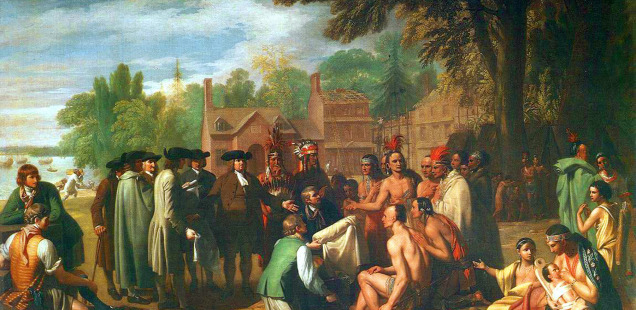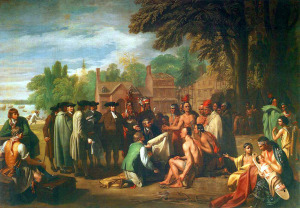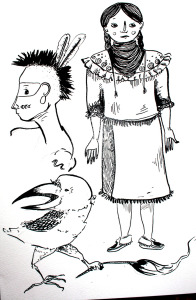
LENNI LENA’PE ~ THE TRUE PEOPLE OF THE POCONOS
Long before Europeans, the Lenni Lena’pe called this area home. These Native Americans were the first inhabitants of the Pocono Mountains, having settled in the area over 10,000 year ago. Lena’pe is pronounced “Leh-NAH-pay” and it means “the people.” Sometimes you will see this name spelled Lenape, Lenápe or Lena’pi. The tribe is also known as the Lenni Lena’pe which translates to “true people” or the Delaware Indians after the Delaware River – The River of Human Beings, which runs through Lenni Lena’pe territory. The word Pocono in the native Lena’pe tongue means “a river between two mountains.” The Lena’pe did not have a written language; their history was passed from generation to generation by storytellers.
Three clans comprised the Lenni Lena’pe nation: Wolf, Turtle and Turkey. The Wolf Clan occupied the land in what is now Monroe County. This clan was referred to as the Munsee or Minsi, the name of their spoken dialect of the Algonquin language. The members of the Wolf Clan were known as “People of the Stony Country.” The Turtle Clan occupied land south of the Lehigh-Delaware confluence, reaching into Philadelphia and were referred to as “People Down the River.” The Turkey Clan lived the furthest south, occupying current-day Wilmington, Del. They were called the “People Who Live Near the Ocean.” The three clans were all sects of the Algonquin tribe and generally lived peacefully with each other. The Lena’pe, however, did conflict with other warring Indian nations, including the Iroquois and the Cherokee.
There are two federally recognized Lena’pe tribes in Oklahoma: the Delaware Tribe of Indians and the Delaware Tribe of Western Oklahoma. Like most Native American tribes, the Delaware Indian tribes are autonomous. Lenni Lena’pes in New Jersey and Pennsylvania are not officially recognized as tribes by the United States. That means they do not have reservation land or their own governmental system, though they still practice the Lena’pe culture.
The Lenni Lena’pes didn’t live in tepees. They lived in villages of round houses called wigwams. Some Lena’pe Indians preferred Iroquoian-style longhouses to wigwams, because more family members could live in a longhouse. The Delaware Indians were farming people. Lena’pe women did most of the farming, harvesting corn, squash and beans. Lena’pe men went hunting for deer, elk, turkeys, and small game, and caught fish in the rivers and inlets.
Because there is no written record left by the Lenni Lena’pe, archaeologists and historians are needed to decipher the life ways of the Pocono’s native peoples. The only written descriptions of the Lena’pe come from European settlers. Early records of contact between the Natives and European colonists in the area date to 1609. There is a detailed account of the 1742 meeting between Chief Kakowatchiky of the Shawnee and Count Zinzindorf, founder of the Moravian Church. One archaeological site, the Shawnee-Minisink site, is unique because it reflects a record of continuous occupation by the Native Americans in the Upper Delaware River Valley, uncovering evidence of extensive habitation of the river valley by Native Americans. The archaeologists’ finds included not only stone tools, but evidence of long-term settlement such as hearths, burial grounds, and post mold-holes for longhouses. Artifacts from the Shawnee-Minisink archaeological site date over 11,000 years old and include hundreds of stone tools, pieces of pottery, remains of fish, animal bones, shells, and fruit and plant seeds.
There are many traditional Lenni Lena’pe legends and fairy tales. Storytelling is very important to the Lena’pe Indian culture. The Lena’pe tribe is also known for their beadwork and basketry products. Like other eastern Native Americans, the Leni Lena’pe crafted wampum out of white and purple shell beads. Wampum beads were traded as a kind of currency, but they were more culturally important as an art material. The designs and pictures on wampum belts often told a story or represented a person’s family.
Lena’pe Indians all speak English today. Only a few Lena’pe elders still speak their native Lenape language also known as Unami. Some young Lena’pe people are working to learn their ancient language again. “he” pronounced “hey” is a friendly greeting and “wanishi” means “thank you.” Many place names in Pennsylvania are derived from the Lena’pe Language, such as Manyunk, Conshohocken, Neshaminy, to mention only a few. In the city of Philadelphia stands a statue of Chief Tamanend, a revered leader among the Lena’pe, who signed many treaties with William Penn. The history of the Lena’pe is truly the history of Pennsylvania and the Poconos.



